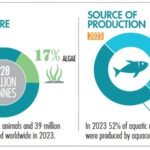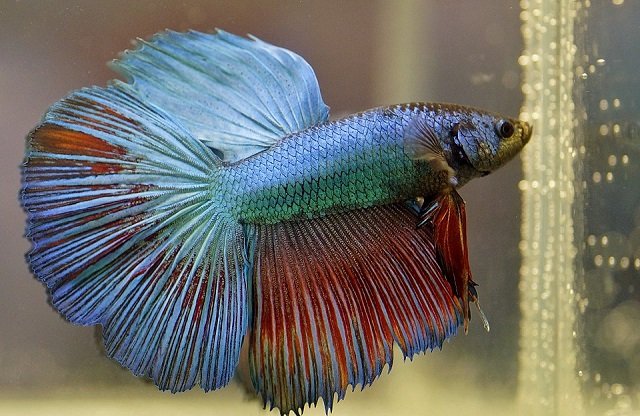The 2018 Edition of “The EU fish market” is now available in English, French, Spanish, German and Italian, and the main topics analysed in the report are listed below.
SLIGHT INCREASE IN CONSUMPTION AND CONTRACTION OF SELF-SUFFICIENCY
In 2016, the EU supply (domestic production + imports) rose by 3% compared to 2015, reaching 14,22 million tonnes. Despite increased production from both aquaculture and fisheries, a greater relative growth of imports resulted in a worsening of EU self-sufficiency, that is the ratio between EU production and apparent consumption of the EU market.
In fact, the top-5 species consumed in the EU – tuna, cod, salmon, Alaska pollock and shrimps – representing 43% of the market in 2016, were mostly imported from non-EU countries.
In 2016, per capita consumption in the EU averaged 24,33 kg, an increase of 763 grams over 2015. The highest amount was recorded in Portugal: with 57 kg, it was more than twice the EU’s average.
An increase in consumption was registered for almost all main commercial species consumed in the EU. Among them, the per capita consumption of herring increased the most. Compared with 2015, it rose from 0,93 to 1,23 kg (+ 32%) and it equalled its average per capita consumption during the period 2007–2013.
HIGHER PRICES AND INCREASING EXPENDITURE FOR PURCHASING FISH
Stay Always Informed
Join our communities to instantly receive the most important news, reports, and analysis from the aquaculture industry.
The EU household expenditure for fish in 2017 reached an all-time peak at EUR 56,6 billion. This was around one quarter of the EUR 221,3 billion spent for purchasing meat. The UK was the only Member State registering a decreasing expenditure for fish (-3% from 2016); Portugal again had the highest per capita household expenditure at EUR 337.
Starting in 2014, fish and seafood prices began to grow significantly and, by 2017, had increased by 10% compared with 2013.
INCREASING VALUE OF LANDINGS AND AQUACULTURE
In 2016, the EU ranked 5th in world production of fishery and aquaculture products, after the four main Asian producers (China, Indonesia, India and Viet Nam).
The main products landed in the EU recorded a price increase, as a result of which the total value of all EU landings reached EUR 7,38 billion, the highest of the last 10 years. The most intense value growth concerned yellowfin tuna (in Spain), herring (in Denmark) and shrimp Crangon spp. (in the Netherlands).
The value of aquaculture products farmed in the EU reached an all-time high of EUR 4,25 billion. In Greece and Spain, 2016 was a record year for the production of European seabass. The total value of salmon farmed in the EU has continued to increase, driven by UK and Ireland production.
PIVOTAL ROLE OF THE EU IN THE GLOBAL FISH AND SEAFOOD TRADE
The EU is the world’s largest trader of fishery and aquaculture products. In 2017, trade flows between the EU and the rest of the world surpassed those of China, the second ranked, by over EUR 2,3 billion.
Despite exports to third countries reaching a value peak, the deficit reached a negative peak of EUR 20,2 billion, EUR 558 million greater than in 2016. Extra-EU imports reached a 10-year peak of EUR 25,3 billion, mainly due to increased imports of frozen cuttlefish and squid, mostly from India and China, and of prepared/preserved skipjack tuna from Ecuador.
Extra-EU exports were valued at more than EUR 5 billion. The US and China are the main markets in value terms for EU exports of fisheries and aquaculture products, mainly importing salmon and cod. The highest volumes are, however, destined for Norway (mainly importing fish oil) and Nigeria (mainly importing herring and mackere).
Intra-EU exports grew by 6% over 2016, reaching EUR 26,7 billion. The largest intra-EU export flows involved salmon that first entered the EU from Norway, before being exported again by northern Member States to other EU markets.
You can download the issue as a PDF here: http://eumofa.eu/documents/20178/132648/EN_The+EU+fish+market+2018.pdf
Editor at the digital magazine AquaHoy. He holds a degree in Aquaculture Biology from the National University of Santa (UNS) and a Master’s degree in Science and Innovation Management from the Polytechnic University of Valencia, with postgraduate diplomas in Business Innovation and Innovation Management. He possesses extensive experience in the aquaculture and fisheries sector, having led the Fisheries Innovation Unit of the National Program for Innovation in Fisheries and Aquaculture (PNIPA). He has served as a senior consultant in technology watch, an innovation project formulator and advisor, and a lecturer at UNS. He is a member of the Peruvian College of Biologists and was recognized by the World Aquaculture Society (WAS) in 2016 for his contribution to aquaculture.




